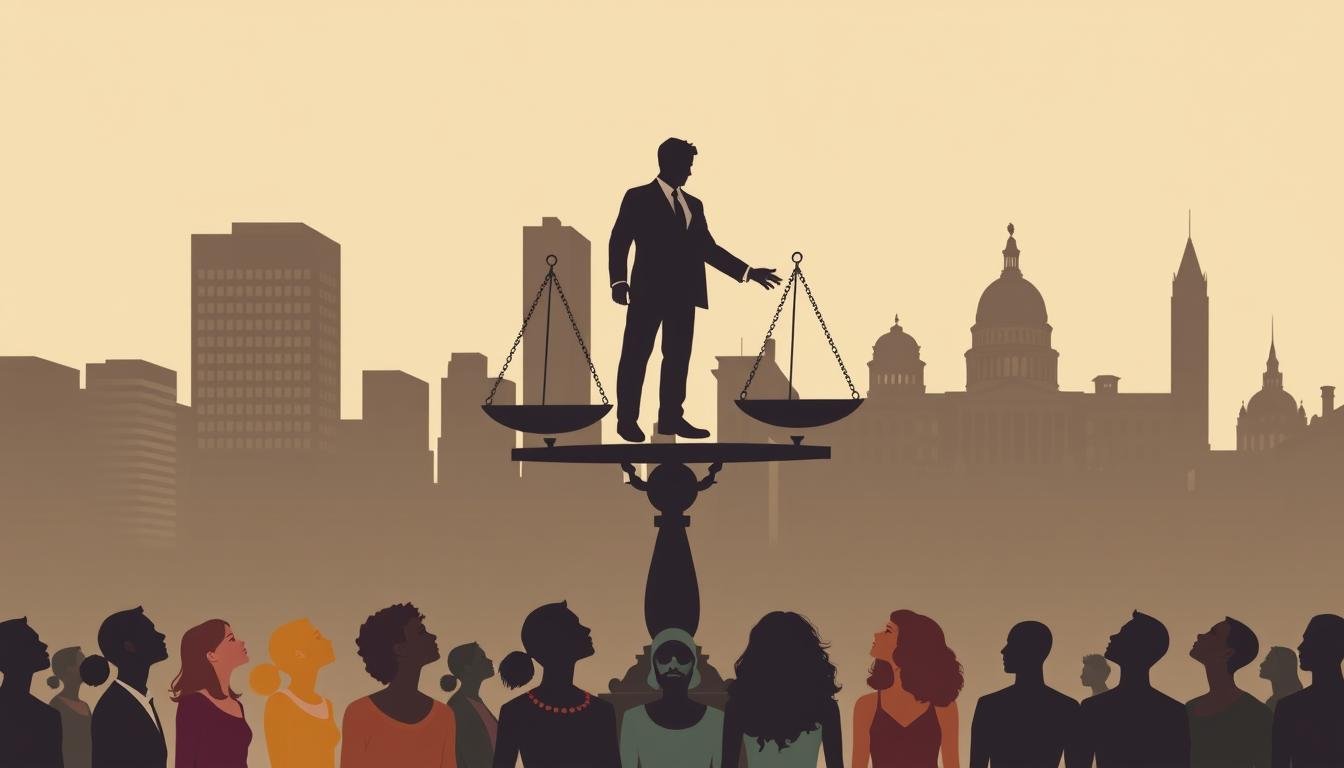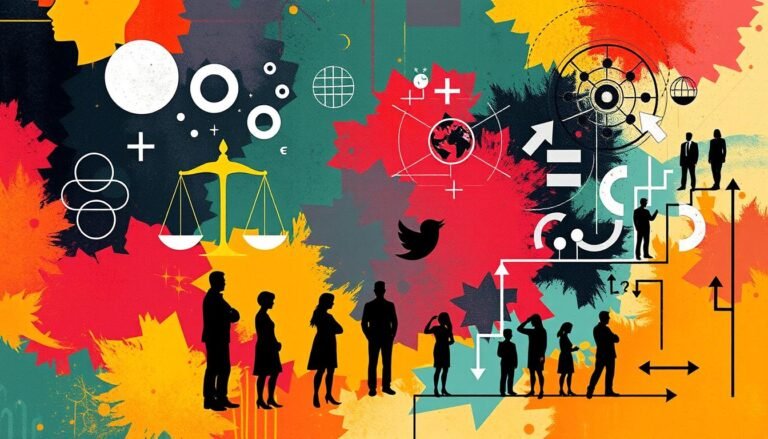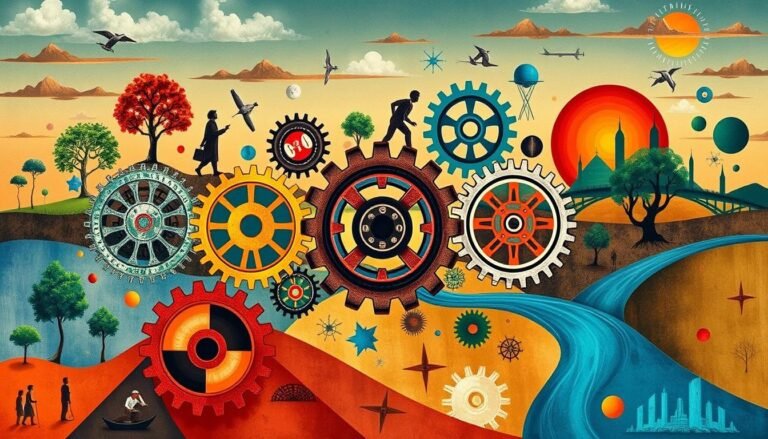Understanding the Role of Patriarchy in Society
Have you ever thought about why men often lead and women face hurdles in their careers? It might be because of a system that’s been around for centuries: patriarchy. This setup puts men in charge and gives them more power and benefits. It affects gender equality, power, and how we organize ourselves.
Patriarchy has shaped our world from ancient times to today. It’s not just about who’s in charge. It’s about how it changes our everyday life, from work to home. Let’s see how patriarchy still affects us and why it’s key to know for a fairer future.
Key Takeaways
- Patriarchy started about 5,000 years ago in old societies
- It keeps gender inequality in education, jobs, and pay
- Men lead because of patriarchal systems
- Patriarchy makes gender violence normal and limits women’s rights
- Media and culture often back patriarchal norms and stereotypes
- Knowing about patriarchy helps us fight for gender equality
Defining Patriarchy: Origins and Core Concepts
Patriarchy shapes our social structures, affecting gender roles and power dynamics. This system of masculine dominance has deep historical roots. It continues to impact modern society.
Etymology and Historical Context
The term “patriarchy” comes from the Greek “patriarkhēs,” meaning “rule of the father.” Gerda Lerner’s research shows that patriarchal systems started over 2,500 years ago. Before then, male dominance wasn’t common in many societies.
Key Characteristics of Patriarchal Systems
Patriarchal systems have men in charge and control over resources. Women often can’t participate fully in politics and the economy, being limited to home duties. Nash’s studies show women are often left out of important positions in these societies.
The Evolution of Patriarchy Through Time
Patriarchy has changed over time but keeps its core idea of male privilege. Feminist scholars believe it starts in the family and spreads to society. The idea of “Male Solidarity” shows how men support gender inequality together.
| Time Period | Patriarchal Characteristics | Impact on Gender Roles |
|---|---|---|
| Ancient Times | Male-dominated leadership | Women restricted to domestic roles |
| Industrial Era | Control over economic resources | Limited workplace opportunities for women |
| Modern Era | Subtle forms of gender discrimination | Ongoing struggle for gender equality |
Historical Roots: Tracing Patriarchy’s Emergence
About 5,000 years ago, patriarchy started in ancient Mesopotamia. Administrative tablets from Uruk show a big change in society. They highlight how women and men were treated differently, hinting at the start of patriarchal power.
Agricultural societies were crucial in forming cultural norms. Farming was seen as a job for men, but women also played a big role. This shows that agriculture didn’t right away lead to gender-based oppression. Instead, it was a slow change in society.
Records from that time tell us that women started to lose their public roles. They were mainly seen as mothers and workers at home. This change was the start of gender hierarchy and the rise of patriarchal systems.
“The discovery that bonobo apes are matriarchal suggests that patriarchy in humans may not be solely explained by nature.”
Not every ancient society was like this, though. The 9,000-year-old site of Çatalhöyük in Anatolia shows little gender difference in how people lived. This makes us rethink traditional gender roles in ancient times and shows the complexity of early societies.
| Society Type | Characteristics | Examples |
|---|---|---|
| Patriarchal | Male-dominated power structures | Ancient Mesopotamia, Modern India |
| Matrilineal | Inheritance and descent through female line | Some societies in Americas, Africa, Asia |
| Egalitarian | Minimal gender differences in roles | Çatalhöyük in ancient Anatolia |
Understanding the Role of Patriarchy in Society
Patriarchy deeply affects how power is shared in society. It puts men in charge, impacting politics and personal lives. This setup also shapes what men and women are expected to do, often leaving women in less powerful roles.
Power Dynamics and Social Structures
In societies ruled by men, they usually control the money and make the big decisions. This is clear in many areas of life. For example, women in the U.S. make about 82 cents for every dollar men earn. This gap in pay adds to gender inequality and keeps men on top.
Impact on Gender Roles and Expectations
Patriarchy shapes our ideas of what it means to be a man or a woman. It pushes men to hide their feelings and women to be more submissive. These strict roles can harm everyone, limiting growth for all. Feminist ideas push against these narrow roles, aiming for more balanced gender expectations.
Intersectionality and Patriarchal Influence
Patriarchy’s effects vary across different groups. Things like race, class, and sexual orientation add to the challenges women face. For example, women of color deal with sexism and racism together. It’s important to see these overlaps to fully understand gender inequality.
“Gender equality seems to be 300 years away due to centuries of patriarchy, discrimination, and harmful stereotypes.” – António Guterres, UN Secretary General
Seeing how deep-rooted patriarchy is is key to making society fairer. By questioning these deep-seated beliefs, we can start to break down the systems that keep women unequal.
Manifestations of Patriarchy in Modern Society
Patriarchy still affects our world in many ways, both big and small. It shows up in the pay gaps and the lack of women in leadership. These issues show how deep power imbalances run.
Cultural norms add to these problems. The #MeToo movement has brought to light the huge issue of sexual abuse and misconduct. It’s pushing against the old power structures.
| Aspect | Statistic |
|---|---|
| Global Gender Bias | 9 out of 10 people hold biases against women |
| Leadership Perception | Widespread bias against women in political and business leadership |
| Gender Roles | Rigid dichotomies enforced for men and women |
| Male Voices | Lack of engagement in gender issue discussions |
These numbers show how deep patriarchal influence goes. Both men and women play a part in keeping these values alive, often without realizing it. Moving past gender stereotypes is key to making progress and achieving equality.
The Impact of Patriarchy on Gender Inequality
Patriarchy shapes society in ways that keep gender inequality going. It affects women’s and other marginalized groups’ economic chances, education, and political say.
Economic Disparities and Workplace Discrimination
In societies ruled by men, women face big economic hurdles. They often get paid less than men for doing the same job. In the U.S., women make about 82 cents for every dollar men earn. This gap is even bigger for women of color. Many women hit a glass ceiling because of workplace bias.
Educational Opportunities and Limitations
Education is a powerful tool, but millions of girls can’t go to school. This is because of old beliefs that boys should get more education. Without education, women have fewer chances for the future, making gender inequality worse.
Political Representation and Decision-Making Power
Women don’t have enough power in politics around the world. This means policies often don’t meet women’s needs. We need more women in politics to fight against male dominance.
| Area | Impact of Patriarchy |
|---|---|
| Economy | Wage gap, workplace discrimination |
| Education | Limited access for girls, gender stereotypes in curricula |
| Politics | Underrepresentation in leadership, gender-biased policies |
Feminist theory says we must break down these male-led structures to achieve true equality. By facing and changing these deep power issues, we can aim for a fair society for everyone.
Patriarchy and Cultural Norms: Shaping Societal Expectations
Patriarchy makes sure traditional gender roles and expectations stick around. These norms affect how people act and interact with each other. For instance, in many places, men are expected to earn money, and women to take care of the family. This setup often stops people from being who they truly want to be.
Things like family, school, religion, and media help keep these norms alive. People start to believe in these expectations from a young age. Changing these beliefs is key to breaking down patriarchal systems.
“Between 1918 and 1940, pink was considered a masculine color, while blue was seen as dainty and soft, making it best suited for females.”
This shows how gender roles and norms can change. It proves that many of our beliefs about gender are made by society, not nature.
| Time Period | Gender Roles | Social Structures |
|---|---|---|
| Paleolithic Era | Men hunted, women gathered | Division based on physical abilities |
| Some Native American Tribes | Women as leaders and healers | Matriarchal societies |
| Modern Societies | Evolving roles for both genders | Challenging traditional norms |
As we move forward, we’re realizing that old gender roles might not be needed or good anymore. Men and women can do many of the same jobs. This means strict gender expectations might not fit in today’s world.
The Psychological Effects of Patriarchy on Individuals
Patriarchy shapes our social structures and gender roles, deeply affecting mental health. It influences how we think and feel about ourselves and others. This goes beyond just cultural norms.
Internalized Gender Biases and Stereotypes
From a young age, we pick up gender biases that shape our self-image and actions. Women often doubt themselves and feel like impostors. Men might hide their feelings. These beliefs can hold us back in personal growth and career choices.
Mental Health Implications for All Genders
Patriarchy takes a big toll on mental health. Women face anxiety and depression at nearly twice the rate of men. Men have shorter lives and higher substance abuse rates. These problems come from strict gender expectations in our society.
Coping Mechanisms and Resilience
Despite these challenges, people find ways to cope and succeed. Support groups, therapy, and learning about gender issues help. Fighting harmful norms and pushing for equality helps everyone’s mental health.
| Gender | Common Mental Health Issues | Coping Strategies |
|---|---|---|
| Women | Anxiety, Depression, Eating Disorders | Support Groups, Self-Care, Therapy |
| Men | Substance Abuse, Anger Issues, Suicide Risk | Emotional Expression, Seeking Help, Challenging Norms |
| Non-Binary | Identity Stress, Social Anxiety, Depression | Community Support, Self-Acceptance, Advocacy |
We can work towards a society that supports mental health for all genders. This means challenging harmful norms and pushing for equality in every part of life.
Challenging Patriarchy: Feminist Movements and Their Impact
Feminist movements have been key in breaking down male-dominated societies. They push for equal rights for everyone. These efforts have led to big changes in laws and society worldwide. They tackle deep-seated gender inequality.
One big win was getting women the right to vote by the 1920s. This was a major step in fighting gender inequality in Europe and North America.
In the 1970s, feminism saw a big push in Western Europe and the USA. This movement focused on ending workplace bias, improving education, and increasing political power. Yet, there’s still a lot to overcome:
- Women still earn less than men for the same job worldwide
- Violence against women is still a big problem with few drops in cases
- Some places don’t have laws against marital rape or child marriage
The internet has brought new ways to fight for women’s rights. Cyberfeminism and networked feminism use technology to challenge old gender norms. They push for equality.
“We need to reshape our own perception of how we view ourselves. We have to step up as women and take the lead.” – Beyoncé
Feminist movements keep changing, tackling complex issues and aiming for big social changes. Even with progress, the fight for equality is tough in today’s digital world and changing politics.
| Wave of Feminism | Time Period | Key Focus |
|---|---|---|
| First Wave | Late 19th – Early 20th Century | Voting Rights, Property Rights |
| Second Wave | 1960s – 1980s | Workplace Equality, Reproductive Rights |
| Third Wave | 1990s – 2000s | Intersectionality, Sexual Liberation |
| Fourth Wave | 2010s – Present | Digital Activism, Body Positivity |
Patriarchy in the Media: Representation and Reinforcement
The media greatly influences our culture and social setup. Recent studies have shown how gender roles are shown and supported in media. A 2021 study by the Global Media Monitoring Project found big differences in how men and women are covered in media.
Gender stereotypes in advertising and entertainment
Advertising and entertainment often keep up gender stereotypes. A 2014 study in the Journal of Personality and Social Psychology found evidence for the social role theory of stereotype content. This means media keeps pushing traditional gender roles. News coverage also shows this, with a 2020 study looking at how news media covers domestic violence.
The role of social media in perpetuating or challenging patriarchal norms
Social media is where we see both sides of patriarchal norms. A 2021 Pew Research Center report showed how these platforms can spread bias. But, social media also lets feminist voices speak out and challenge old norms.
Media literacy and critical analysis
Learning to understand media is key to spotting and questioning patriarchal images. Studies have looked at how media affects young people’s views on body image and gender. By teaching critical thinking, we can better handle the complex media world. This helps us fight against harmful patriarchal norms in our culture.
Source Links
- The Origins of Patriarchy
- Critical Overview of Patriarchy, Its Interferences With Psychological Development, and Risks for Mental Health
- Understanding Patriarchy | Bell Hooks
- Patriarchal Society According to Feminism
- How did patriarchy actually begin?
- The Philosophical Origins of Patriarchy
- Patriarchy hurts men and women
- What is patriarchy? What does it mean and why is everyone talking about it?
- Analysis: How did the patriarchy start – and will evolution get rid of it?
- Renowned Therapist Explains The Crushing Effects Of Patriarchy On Men And Women Today
- Patriarchy
- We are all victims of a patriarchal society: some just suffer more than others – Cordaid International
- Gender norms and social norms: differences, similarities and why they matter in prevention science
- Gender Roles in Modern Society – One World Education
- The Psychological Toll of Patriarchy on Women
- How Patriarchy Hurts Men Too — Next Gen Men
- AA
- Feminism and Women’s Rights Movements – Gender Matters – www.coe.int
- Ending The Patriarchy: A Pathway to Equality and Regeneration | Population Media Center
- Against Patriarchy: Tools for Men to Further Feminist Revolution* – National Organization for Men Against Sexism
- Gender and Media Representations: A Review of the Literature on Gender Stereotypes, Objectification and Sexualization
- The Cycle of Exclusion in Local Print News: How News Content Reflects and Reinforces Patriarchy







